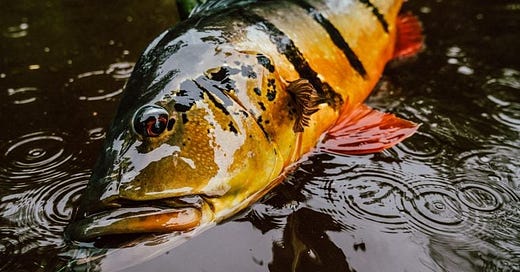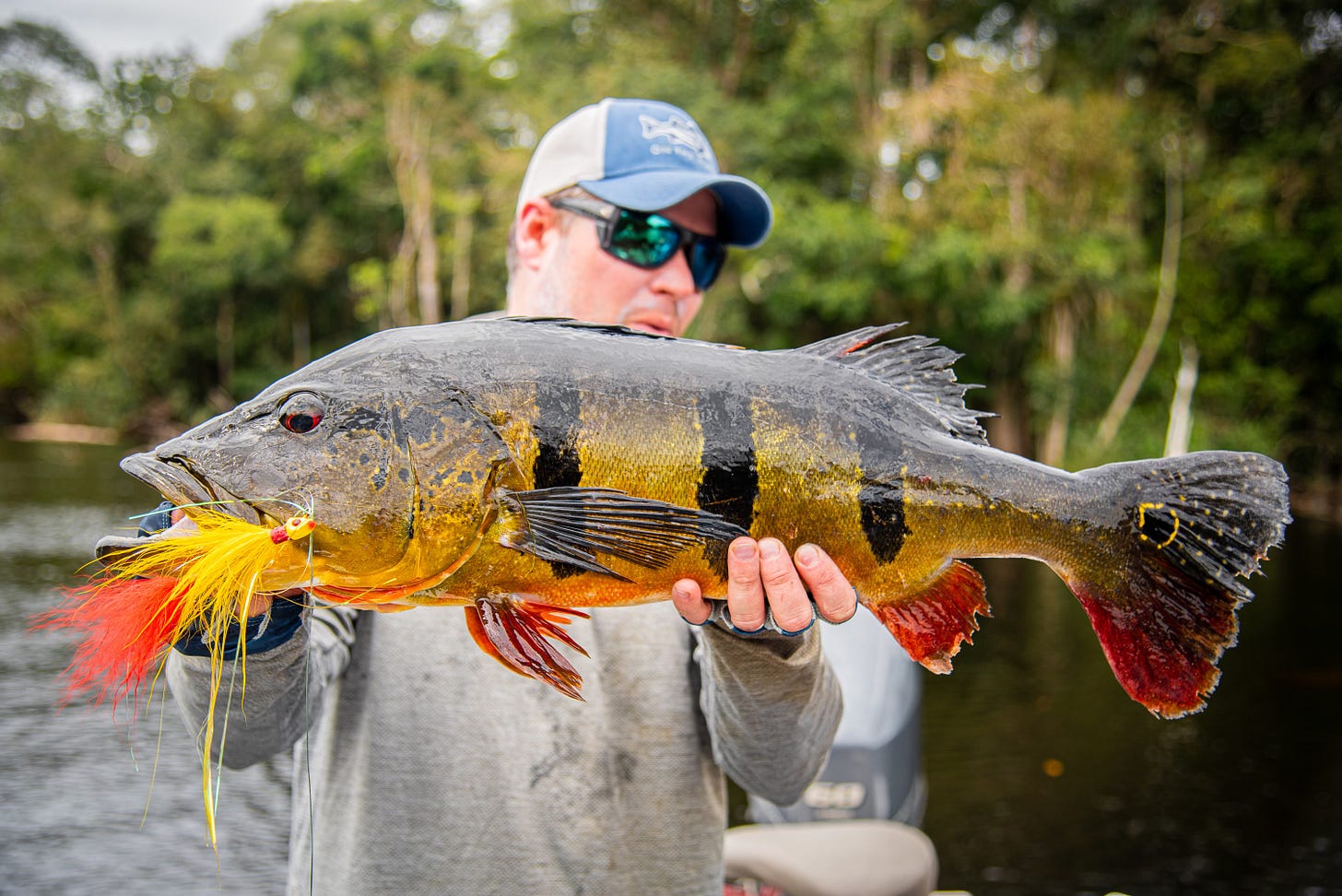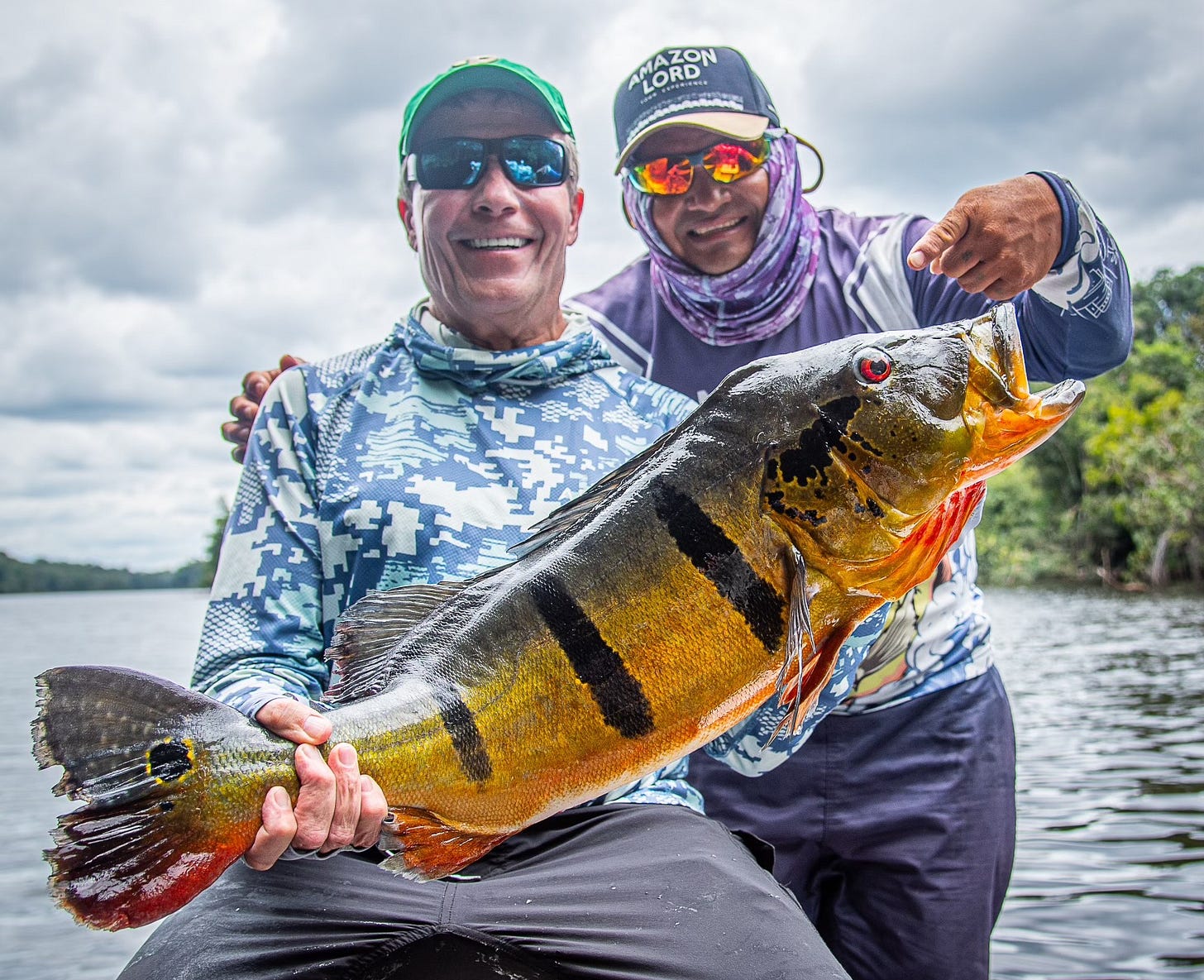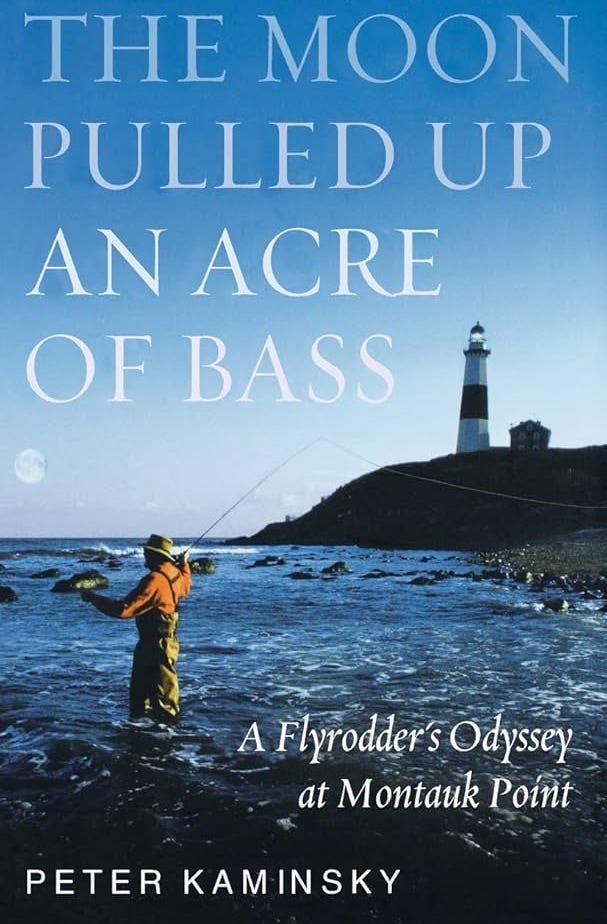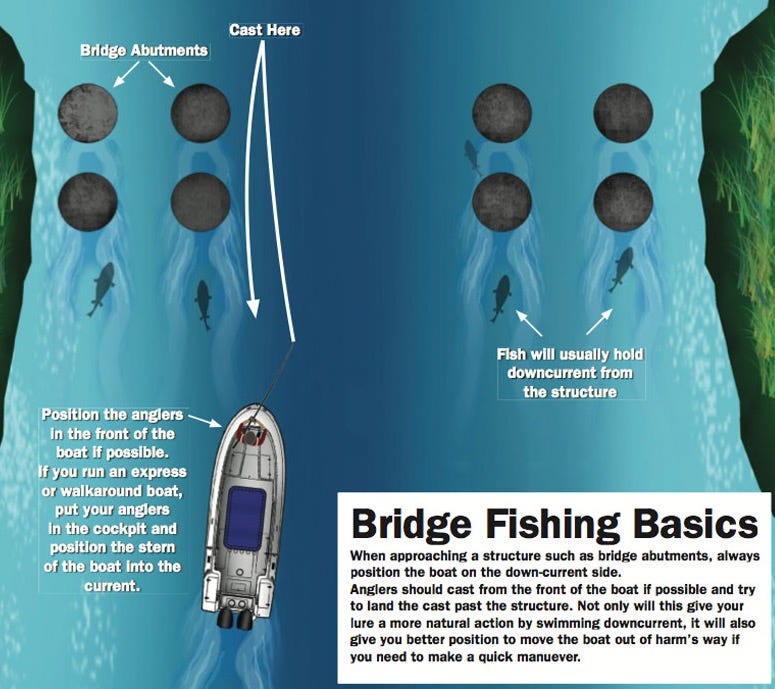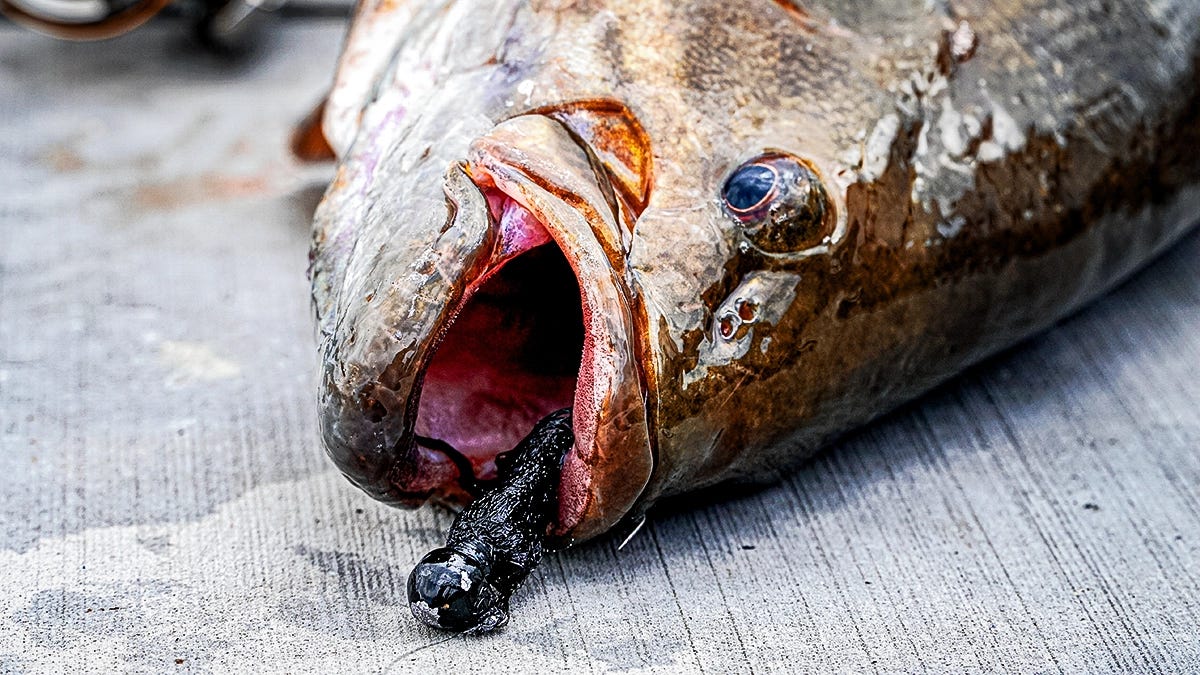The maritime rule of salvage has its origin in Roman law, which dictates that one who preserves or improves upon the misplaced property of another is owed compensation, even if the service was not requested. Let’s get out the internet trawler and get to work…
🎙️| Cut & Retie Podcast: Flat-brimming in International Waters —> Today’s salvage is going to be a bit peacock heavy, if you can’t tell from the artwork. So grab your 50lb braid, a few wood-choppers, and let it fly.
🎙️| Saltwater Tales Podcast: The Italian vs The Russian —> A fresh sushi-centric podcast from Jersey with some familiar faces involved. Good storytelling, some Bluewater philosophy and tactical nuggets included.
🎥 | Glide-Bait River Muskellunges (NDYakAngler)
Fishing Reports | OnTheWater - FishermanMag - HullTruth - MAFishReport - SOL
***Reminder to renew your fishing licenses here. HMS vessel permits here.***
Gear Guide by Tak Waterman | Harness Protail X TAK
Sizes | 9” 6oz Colors | Bunker, Pink
Description | Specifically designed for giant BFT pushing Pogies, it comes custom-rigged with a 240lb swivel, 500lb through-wired construction and 4X VMC 7691S.
Q&A with International Bass Intellect, Jimmy Fee
Before the 17th Century, they were simply known as "tucunare” to the indigenous, meaning "big fish”. Portuguese naturalists and then Alexander von Humboldt, the famed Prussian explorer with a squid named after him, recorded their shades of fire and jade during his early 19th-century travels. In the 1950s, American sportsman and writer Zane Grey described expeditions where strikes proved so violent that rods snapped and reels smoked. By the 1970s, they were being imported to Florida and Puerto Rico en masse…but the mystique would never leave the Brazilian jungle. This week, our newly-minted foreign bass correspondent, James Fee, reports back after a vision-quest to the delta of dreams.
Q - How did you fare in the verdant and virgin backwaters of Brazil? Highlights, low-lights, enough cold Brahma Lights?
I occasionally suffer from a case of unrealistic expectations when it comes to fishing, so on the flight into Barcelos, Brazil, the jumping off point for our trip, I envisioned every lure that hit the water getting immediately attacked by some sort of Amazonian predator. The promotional materials from the outfitters of these trips do little to dissuade you of these notions, too. Of course, it wasn't like that. Fishing isn't like that anywhere in the world.
After the first half-day of fishing, I was brought down to earth. You have to actually fish for the peacocks to catch them. Accurate casts into dense, flooded jungle were needed to draw out the bigger fish. I loved it. I do wish I'd practiced with a bait-caster a little before the trip to avoid what the guides called "fishing for monkeys," but by day 3, I was spending less time in the trees and more time in the water.
My dad and I hit our lowlight in the middle of the trip, a day when we struggled to put six fish in the boat in torrential rains with one rain jacket between us, while other boats came in having caught literally dozens of fish. It took a few caipirinhas to take the sting off that one. But, it set up a redemption arc, and the final two days of fishing were our best of the whole trip. Plus, after one of the good days, we got to watch the Eagles win thanks to Starlink.
One of the fishing highlights was the last day, the last 10 minutes of fishing. It was the biggest fish I hooked all week. Came stampeding out of a fallen tree after a Rebel Jumpin' Minnow, missed twice before taking it down. The fish took a bullish run into the structure, then miraculously turned toward open water, but with that turn the hook fell out. A bummer for sure, but a great final image of peacock bass fishing.
Q - Did you bring any good reads along? And what is your Mt. Rushmore of Striped Bass books?
I brought ‘Tributaries’ by Ryan Brod, a Maine guide and writing teacher. It was a collection of his essays about fly fishing and hunting in Maine, with some Floridian anecdotes sprinkled in. The fly-fishing essay was mastered by John Gierach, who passed last year, but Ryan, who's my age, offers what's to me, a more relatable perspective on fishing and life.
I'd lead with ‘20 Years on the Cape’ by Frank Daignault. It's a look back at the halcyon days of striper surfcasting, and also a look at its previous decline. I return to that book every summer, hoping to experience my own Pochet Hole blitz.
I was woefully late in reading ‘The Moon Pulled Up an Acre of Bass’ by Peter Kaminsky, but that is a classic. It's another look at a more recent "good ol' days” in early 2000s Montauk, where blitzes were a daily occurrence. Kaminsky took a fall off to fish the fall run at Montauk and document each day. I especially like how he pooh-poohed albies in favor of bass.
‘Reading The Water’ by Robert Post has to be up there. He interviews many of Martha's Vineyard's most dedicated surfcasters, documenting the stories of great blitzes, and Derby infamy. I believe it's out of print, but worth a read if you can find it.
Filling out the fourth spot is difficult. ‘Surfcasting Around the Block’ by Dennis Zambrotta is worth the read for the accounts of the incredible striper fishing that happened there in the 1980s, but it loses steam in the instructional sections. ‘Night Tides’ by Michael G. Cinquemani provides an interesting look at one of striper fishing's most infamous characters, Billy the Greek, but the writing is rough in places.
Q - I've also been reading up on ‘The Greek’ (no doubt an inspiration for Bob the Garbage Man) and need some clarification; what is your theory on big striped bass and bridges?
My early striper fishing was almost all from atop bridges in Southern New Jersey. There was a whole culture around it that I loved, from greasing the palms of the toll-takers with fresh fish so they'd look the other way, to mastering use of the rope gaff when you were solo in order to land your fish from 40 feet above the water.
Bridges are big pieces of structure that are often built across natural pinch points and areas where the current accelerates. So, you're taking a place that naturally attracts fish, and adding more, man-made fish-attracting structure with the pilings and the lights. I never caught a 50-pounder from a bridge, like Billy The Greek, but I've seen some big fish holding on the dark side of the shadow line with their noses pressed right up against the light. It's a sight that takes your breath away as you line up your cast to get the perfect sweep with the jig.
The challenges now are access and catch-and-release friendly landing procedures. My "Townsend's Inlet Talon," a 12/0 weighted treble tied to 60 feet of 1/4-inch rope with a shower curtain ring to clip to the line wouldn't qualify as legal to use today.
Q - After claiming your first White Marlin this past year, on a bay boat of all vessels, what is your next great offshore ambition? Any new goals from the surf?
Offshore: I want a nighttime swordfish in the worst way - aboard a headboat would be even better. Failing that, I'd settle for a 60-plus-inch bluefin. 2024 was great for 30-45-inchers, but I'm ready to be hurt again by a bigger fish on light tackle.
Surf: Range a little wider this season. In 2024, with a new baby, getting out of the house early enough to fish spots 60 to 90 minutes from home was trickier. Things should be a little more settled by the time the big bass return in May. Also, catch a cod from the beach this winter.
Lightning Round!
Most underrated species in the Northeast?
Freshwater: Chain Pickerel /
Saltwater: Tog used to be the easy answer here, but now maybe weakfish.
Best surfcasting slang term?
One of my favorites is "I'm in!" instead of "I'm on!" for letting someone know you've hooked a fish. This may be one I picked up in Montauk, which would make sense because Long Islanders seem to mix up their ins and ons.
Largemouth confidence lure?
Bull Shad Bull Wake in Dirty Bone. Big enough to call up a big one, small enough to provide some action on slow nights.
Last thing you left in the On The Water office fridge?
A freshly gyotaku-ed Chain Pickerel. Last thing we should have put in the refrigerator was a bottle of Anthony DeiCicchi's homemade fermented hot sauce. We did not, and it exploded and nearly maced Robbie Tartaglia.
Worst tackle purchase of 2024?
I bought a high-end freshwater bass rod specifically for fishing suspending jerkbaits. I know how effective they are, but I can never seem to make them work. So, like any lousy carpenter, I blamed the tools. Now, with a $300 rod and a collection of $25 jerkbaits, I am forced to admit that I just can't fish jerkbaits.
Fabled Truth: The Striped Bass of Chaleur Bay (AnglersJournal) - “The boat had spooked a school, though not the sporadic wolf pack I was used to from other flats trips. This was a school of 60 or so fish that scattered in all directions when we slid to a stop. Murphy climbed atop the poling platform and began to maneuver through the shallows. The bottom is sandy, but there were large patches of eel grass every couple of yards. I could see crabs scurrying on the bottom. Murphy told me that grass shrimp were the preferred meal for these fish and that little Clousers and epoxy shrimp will always get an eat. “You got line stripped out and ready to go?” he asked, scanning the horizon. I was so gobsmacked by the fish we had just seen that I struggled to get the rod ready. “Fish coming at eleven.””
Hair Jigs: The Secret for Putting Big Cold-Water Bass In the Boat (Wired2Fish) - “The hair jig was first brought into the bass fishing scene down Dale Hollow Lake in Tennessee for targeting big smallmouth feeding on baitfish and crayfish extremely close to the bottom. It was something anglers could use to drag along the bottom that had enough action to entice big smallmouth into biting when the water temperature dipped below 45 degrees. Once that jig comes off the bottom, it’s going to look extremely unnatural in the water. You want to feel every little rock, pebble, and boulder that jig hits all the way back to the boat. Usually, when the bait falls or pulls off a rock is when the bite comes. Depending on the fish’s mood, the bite could be ferocious or just dead weight.”
Looking for more information about a product after reading The Weekly Salvage?
Try using GearSay, the first generative AI tool for finding the right fishing tackle.
Type in a question like “what are some popular pre-spawn bass jerk-baits for under $15?" to get instant results.
Thanks for reading The Weekly Salvage, until next week!
Have feedback or want to learn more?
Reach out to us on IG @Blowin_We_Goin

